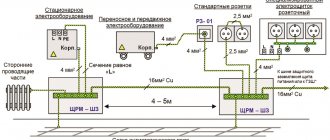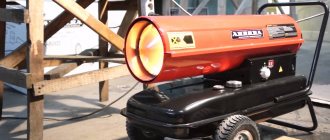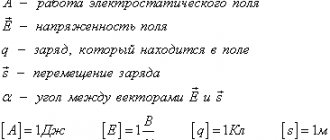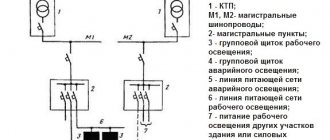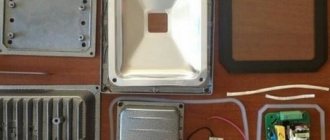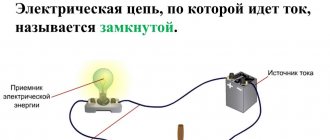Electricity has long become an integral part of the daily lives of each of us. People are so accustomed to this benefit that they sometimes forget about the dangers that may arise during the operation of electrical installations (household electrical appliances). At the initial stage of designing the power supply of any facility, special attention is paid to safety. Almost all users of electrical appliances know what a bare wire, insulation, and grounding are. But the term “potential equalization” is familiar only to professional electricians. If we don't see external signs of a problem, a false sense of non-danger arises. And this despite the fact that alternating voltage above 42 volts can be fatal to humans.
When can voltage or electric current pose a threat to health or life?
The presence of voltage (or potential) in itself does not pose any problem. The danger is electrical current. It occurs when there is a potential difference between the ends of the conductor.
It is important to know! The human body is a good conductor for electric current due to the presence of fluid in the cells.
What is potential difference
For example, let's take a regular AA battery. On its positive contact there is a potential of approximately 1.5 volts, on the negative one - 0 volts. If you connect a measuring instrument (multimeter) to the positive terminal (using both wires), the value will be zero. And if we measure between “plus” and “minus”, we will see a voltage of 1.5 volts on the device.
Why is this happening? There is a potential difference of 1.5 volts between the positive and negative contacts. Accordingly, if you connect these terminals with a conductor (electrical circuit, metal wire, etc.), electric current will flow between them.
How does this work using electrical appliances as an example?
Let's take a 220 volt household outlet. At the phase contact there is a potential of 220 V, at the zero contact - 0 V. Between them there is a potential difference of 220 volts. If you connect the contacts with a piece of wire with low resistance (conventionally 1 Ohm), then an electric current of 220 amperes will arise in the conductor (according to Ohm’s law). Of course, in practice this cannot be done; the wire will instantly melt and the insulation will catch fire.
If a person grabs two contacts, then despite the high resistance of the body, the current strength will be enough to cause a fatal outcome.
All devices that produce electricity have a zero contact connection to the “ground”: literally to the physical ground. This means that between any phase wire and the physical ground there is always a potential difference equal to the phase voltage.
The same thing happens in indoor conditions (residential, industrial, etc.). A phase can be supplied to the body of the electrical appliance. This can occur in an emergency: damage to the insulation, moisture entering the contact group, or a malfunction of the power supply. If you simultaneously touch a live enclosure and an element of the premises infrastructure that has an electrical connection to physical ground (for example, a pipeline), there is a danger of electric shock.
If the electrical appliance is properly grounded, the phase on the housing is connected to the ground: a short circuit occurs and the circuit breaker disconnects the circuit. No electric shock occurs.
This is an ideal situation when the premises comply with the standards of the Electrical Installation Rules (PUE).
In practice the situation may be different
Let’s say your neighbor next door connected the neutral wire to the heating system (we won’t consider the reasons: from simple illiteracy to the desire to rewind the electricity meter). A dangerous potential occurs on metal pipes: from 50 to 220 volts. Theoretically, the voltage should “go into the ground”, since the steel pipes are laid in the ground. However, if a section of the pipeline is replaced with plastic between your apartment and the basement, the conductor opens. And your bathroom heated towel rail has a potential of, say: 170 volts.
You are touching a metal pipe and a grounded washing machine. The same potential difference arises (with a life-threatening voltage), only the source of the problem is not your electrical appliance, but the energized heated towel rail pipe.
As can be seen from the illustration, protective grounding does not work in this case.
Let's consider another option:
You have a power wire in the wall, next to which there is a water pipe. Under load (for example, a boiler or electric oven is turned on), an EMF (electromotive force) can be induced in the pipe. The water will receive an unwanted potential, up to 50 volts. This may not be a fatal voltage, but when you touch the faucet in the kitchen, you will feel an unpleasant tingling sensation of electric current. Especially if there is steel reinforcement in the floor screed, which has contact with the physical soil along the damp walls of the room.
In this case, the working ground also does not work.
Reasons for the appearance of electrical potential differences
In addition to obvious conditions, such as breakdown of insulation on the body of an electrical installation, or unauthorized connection to structural elements, there are hidden factors:
- Static voltage. Occurs due to friction (for example, the movement of water in a plastic pipe), dry air, dusty rooms.
- Electrochemical potential accumulation that occurs during the interaction of dissimilar metals.
- Atmospheric phenomena (thunderstorm, strong wind) contribute to the accumulation of electrical potential.
- Stray and induced currents, electromagnetic radiation (microwave ovens, switching power supplies, monitors, TVs).
How to protect yourself from such situations? The electrical installation rules (PUE) provide for a potential equalization system.
Leveling and Leveling
Let's look at the basic concepts and terms:
- Potential equalization is the leveling of the difference in electrical potential values between the metal elements of an electrical installation in the room where the electrical installation is located, including the conductive elements of the building. In this case, a situation is considered dangerous when it becomes possible for a person to simultaneously touch conductive parts. It is achieved by non-disconnecting connection of all current-carrying parts to each other using conductors.
- Potential equalization is a system for reducing the relative difference in electrical potential between grounding, accessible conductive parts of electrical installations, the surface of the earth and all metal structures of the building. To do this, the potential equalization system must have an unbreakable connection with the working (protective) grounding conductor.
In addition, potential equalization includes reducing the electrical potential difference on the ground surface (floor, ceilings) to prevent the effect of step voltage.
What does the term "unbreakable" mean? All conductive lines are permanently connected to each other (contact blocks, screw connections, soldering, welding, etc.). It is not allowed to install disconnecting devices: fuses, switches, circuit breakers. That is, the entire potential equalization system is a single conductive circuit combined with a similar protective grounding circuit.
Thanks to these systems, in all points that a person can simultaneously touch, the electrical potential is equalized to the same value. The situation when, when touching at the same time, the voltage will be 220 volts at one point and 10 volts at another, is excluded.
Your home becomes absolutely safe.
Important! The system only works when all metal objects without exception are combined. If at least one element or electrical installation is excluded from the connection by conductors, consider that the entire circuit is inoperative.
Another danger if there is no additional potential equalization
The bathroom is dangerous for other reasons as well.
In addition to metal parts, there is dampness in the bathroom and at the same time many different electrical appliances.
Such a dangerous combination requires extreme caution. In this regard, transformations in the form of potential equalization
. What does it mean?
All metal parts, objects of a stationary nature, are connected by a PE conductor (protective grounding) and taken to one common box KUP (abbreviation KUP - potential equalization box) in the DSUP system (abbreviation DSUP - additional potential equalization system). Then, from the PMC box, the common conductor is led out to the common PE terminal (protective ground), which is located in the distribution board. So we leveled out all the potentially dangerous parts, and tried to make the bathroom a safe and quiet haven.
What is the difference between a potential equalization system and a protective grounding system?
Grounding is an intentional non-detachable electrical connection of parts of an electrical installation or circuit with a ground electrode. Designed to reduce voltage (to a point where it should not exist under normal operating conditions) to a safe level.
As you can see, the definition does not contain the concept of potential (potential difference). In addition, grounding is carried out only at electrical installations or electrical circuits. Potential equalization also applies to infrastructure elements, as well as metal objects that are not electrical installations.
At the same time, protective grounding works effectively only in combination with protective shutdown devices (fuse links, circuit breakers). Without such devices, grounding does not reduce the safety of electrical installations, and can lead to a fire if a phase-to-ground fault occurs.
Unlike grounding, the potential equalization system is self-sufficient; no additional protective devices are required. The only condition is that there is an electrical connection to physical ground.
Requirements for organizing a potential equalization system in the PUE
There is no clear and universal definition of this system in the Electrical Installation Rules. The potential equalization device is specific depending on the location of application. Different types of premises, when working with different types of electrical installations and laying current-carrying lines, have their own techniques.
For example, consider the application of portable protective grounding during repair work in electrical installations with three-phase power:
All current-carrying busbars within one electrical installation are connected to each other (potential equalization) and then connected to the ground electrode (potential equalization). If voltage appears on any of the parts, there will be no difference in electrical potential, the work is carried out in safe conditions.
The PUE has a list of protective measures, where this system is mentioned as one of the points required for use:
- organization of protective grounding;
- automatic power supply shutdown;
- equalization of potentials;
- potential equalization;
- double or reinforced insulation of conductors and electrical installation housing;
- organization of low voltage power supply (for alternating current - no higher than 50 volts);
- protective separation of electrical circuits;
Reasons for using potential equalization
First, you need to decide what causes the difference and, as a consequence, the subsequent need for equalization:
- the occurrence of static electricity;
- differences in the structure and structure of metal structures;
- increased atmospheric pressure that occurs during unfavorable weather conditions, such as thunderstorms;
- influence of stray current.
All devices made of metal are connected to each other, therefore, when a potential difference appears between individual structures, when a person touches several objects, it immediately results in an electric shock.
Note! An example of such a hazard is a situation where a person takes a shower and receives an electrical injury. This occurs due to the fact that current passes through the human body, as if through a conductor, from an object with greater potential to an object with less.
To avoid such life-threatening situations, the potential difference is reduced or eliminated using grounding.
Creation of potential equalization systems
The design of each system is individual and is developed in accordance with the configuration of the room. There are general installation rules that must be followed:
- The potential equalization bus and the protective grounding bus must be connected or combined into one unit.
- All objects: electrical installations, trays, bathtubs, sinks, building infrastructure elements are connected to the potential equalization bus in parallel.
This means that each element has a separate conductor connected to a common bus. Serial connections between objects are not allowed. If the primary conductor is broken, all subsequent objects on the line will be disconnected from the potential equalization system. - Along the entire length of current-carrying lines, there should be no switching or disconnecting devices: switches, relays, fuses.
- The connection must be reliable: no twisting or wrapping with electrical tape is allowed. Welding, screw connections, and standard contact clamps are used.
What objects are connected to the potential equalization system
- Metal enclosures of all electrical installations (unless they are properly grounded). The list also includes conductive housings of lamps (floor lamps).
- Of course, the entire protective grounding system. Actually, this is where the potential equalization system begins.
- Metal parts of the building frame, reinforcement of the foundation, walls, ceilings.
- Self-installed metal infrastructure elements. For example, a steel mesh under a floor screed or a metal profile under sheets of drywall.
- Metal pipes and casings of the ventilation system.
- Copper pipes of the refrigerant supply system in air conditioners (if they are long).
- Metal sheaths of armored cables.
- Screen braiding of information cables (television, Internet).
Let's dwell on this point in more detail. The braided cable starts from a distribution or amplification device that is located far outside your premises. However, you have no way to control the correct power supply or grounding of these devices. A situation may arise when a phase comes across the screen to your house.
Without suspecting anything, you can simultaneously touch a live braid and a grounded metal object (for example, a heating radiator). The consequences are obvious - electric shock. When connecting the screen to the potential equalization system, external phase breakdown on the cable is not dangerous.
- All metal parts of the water supply and sewerage system: pipes, faucets, stainless steel sinks, trays and metal shower cabins, bathtubs.
- Components of water heating systems: boilers, internal pipes.
- Heating system: pipes, radiators, heated towel rails.
- Gas supply system.
- Lightning protection grounding (if you have a private home, the “option” is not available in apartment buildings). In this case, the lightning rod is connected to the general system and its own grounding conductor at the same time.
- Metal-plastic window frames (if the conductive elements are not covered with plastic).
- Steel doors and door frames.
In the diagram it looks like this:
- Potential equalization bus.
- Lightning arrester from the power panel. Connected to phase. In the normal state, there is no contact between the phase and grounding conductors - there is sufficient gap in the arrester. When lightning strikes a power cable, an arc current occurs to the ground, and a potential difference of several thousand volts will not occur.
- Data line surge suppressor.
- Brackets for fastening grounding conductors to metal pipes.
- Fundamental grounding conductor with busbar, part of the overall potential equalization system.
Potential equalization system
To bookmarks
- Design of the main potential equalization system.
- Installation of an additional potential equalization system.
What is a potential equalization system and why is it needed?
According to the PUE* (clause 1.7.32.): Potential equalization is the electrical connection of conductive parts* to achieve equality of their potentials.
Why is a potential equalization system needed? To figure it out, let’s imagine a bathroom power supply diagram:
From the above diagram it can be seen that the current, when the washing machine is plugged into an outlet, passes through its electric motor and returns back to the network through the N-bus along the neutral wire. The body of the washing machine is grounded (grounded) from the same N-bus; this is necessary so that if the insulation in the washing machine is damaged and there is a short circuit to its body, the voltage will be cut off by the protection device. But because the body of the washing machine is connected to the same N-bus through which current flows through the neutral wire, there is a danger of current flowing from the neutral wire through the N-bus to the body of the washing machine and the appearance of an electric potential on it.
For reference: The direction of current movement is conventionally taken to be the direction of electrical energy - from the generator to the consumer.
As you know, voltage (denoted by the letter U) is the difference in potential of two points (denoted by the letters φ1 and φ2):
U= φ1 - φ2
For example, in our case, the phase wire has a potential of φ1=220 Volts, and the neutral wire has a potential of φ2=0 Volts, then the voltage between the phase and neutral wires (mains voltage) will be equal to:
U=220 - 0 =220 Volt
In addition to the neutral wire, all conductive structures of the building that have contact with the ground also have zero potential, for example: heating system, metal pipes for supplying hot and cold water, metal gas pipe, building fittings, etc.
Let's imagine a situation: on the body of the washing machine, as a result of the connection diagram shown above, an electrical potential appeared equal to, for example, 30 Volts, at this time a person, having taken a bath, leaned on the washing machine, reached for a towel and touched the heated towel rail, which, through the system heating has a connection with the ground (i.e. its potential is zero), a person can receive an electric shock, because Current, as we know, flows along the path of least resistance:
The tension between the hands (i.e. between points “A” and “B”) will be equal to:
U= φ1 - φ2=30 - 0 =30 Volts
where: φ1 is the potential on the washing machine body; φ2 - potential on the heated towel rail
The current will pass through the body of the washing machine, then along the hand-to-hand circuit to the heated towel rail and from it through the heating system to the ground, in addition, the current can also pass through the hand-to-foot circuit, because The floor in the bathroom, as a rule, is also conductive.
In order to prevent such a development of events, a potential equalization system is used:
In this case, even if the above situation occurs with the appearance of an electrical potential on the body of the washing machine, a potential of the same magnitude will arise on all conductive structures and therefore the voltage between any points of the building will be zero.
For example, a potential of φ1 = 30 Volts appears on the body of a washing machine, in this case a potential of the same value φ2 = 30 Volts will appear on all conductive structures of the bathroom through the potential equalization system. The voltage in this case will be equal to:
U= φ1 - φ2= 30 - 30 = 0 Volt
2. Construction of a potential equalization system.
The potential equalization system (PES) is divided into main (OSUP) and additional (DSUP).
2.1 Design of the main potential equalization system.
The main potential equalization system (BPES) is carried out, as a rule, during new construction or reconstruction of a building and must provide for the connection of the following conductive parts to the main grounding bus (PE bus) * (according to clause 1.7.82. PUE):
1) neutral protective conductor of the supply line;
2) a grounding conductor connected to the re-grounding electrode at the entrance to the building (if there is a ground electrode);
3) metal pipes of communications entering the building: hot and cold water supply, sewerage, heating, gas supply, etc.
If the gas supply pipeline has an insulating insert at the entrance to the building, only that part of the pipeline that is located relative to the insulating insert on the side of the building is connected to the main potential equalization system;
4) metal parts of the building frame;
5) metal parts of centralized ventilation and air conditioning systems. If there are decentralized ventilation and air conditioning systems, metal air ducts should be connected to the PE bus of the power supply panels for fans and air conditioners;
6) grounding device of the lightning protection system of the 2nd and 3rd categories;
7) grounding conductor of functional (working) grounding, if there is one and there are no restrictions on connecting the working grounding network to the protective grounding device;
 metal sheaths of telecommunication cables.
metal sheaths of telecommunication cables.
Conductive parts entering the building from the outside must be connected as close as possible to the point of their entry into the building.
The connection of the conductive parts of the main potential equalization system must be carried out according to a radial diagram, i.e. Each conductive part must have a separate grounding conductor from the PE bus.
The cross-section of the conductors of the main potential equalization system must be at least half the largest cross-section of the protective conductor of the electrical installation, if the cross-section of the potential equalization conductor does not exceed 25 mm2 for copper or equivalent to it from other materials. The use of conductors of larger cross-sections is, as a rule, not required. In any case, the cross-section of the conductors of the main potential equalization system must be no less than: copper - 6 mm2, aluminum - 16 mm2, steel - 50 mm2. (clause 1.7.137 PUE)
As can be seen in the diagram presented above, all conductive parts included in the main potential equalization system are connected to the Main Grounding Bus (GGB) with separate conductors, and the MGB itself must be grounded by connecting it to the ground loop.
Inside the incoming electrical panels in accordance with clause 1.7.119. The PUE should use a PE bus as a main bus. Let’s look at what this looks like using the example of connecting a gas pipe from a private residential building to the BPCS:
To connect the conductors of the potential equalization system to the pipes, special clamps are used:
2.2 Installation of an additional potential equalization system.
The additional potential equalization system (ADUP) must connect with each other all simultaneously accessible open conductive parts of stationary electrical equipment and third-party conductive parts, including accessible metal parts of building structures, as well as neutral protective conductors in the TN system and protective grounding conductors in IT and IT systems. CT, including protective conductors of plug sockets. (clause 1.7.83. PUE)
Thus, DSUP is mandatory for premises with an increased risk of electric shock to a person, in which there is the possibility of simultaneous contact of a person with open conductive parts of stationary electrical equipment on the one hand and with a third-party conductive part on the other.
For bathrooms and shower rooms, an additional potential equalization system is mandatory and must include, among other things, the connection of third-party conductive parts extending outside the premises. If there is no electrical equipment with neutral protective conductors connected to the potential equalization system, then the potential equalization system should be connected to the PE bus (clamp) at the input. Heating elements embedded in the floor must be covered with a grounded metal mesh or a grounded metal shell connected to the equalization system potentials. As additional protection for heating elements, it is recommended to use an RCD for a current of up to 30 mA (clause 7.1.88. PUE).
IMPORTANT!: It is not allowed to use local potential equalization systems for saunas, baths and shower rooms. (Clause 7.1.88. PUE).
Thus, the additional potential equalization system is intended to complement the main potential equalization system and should not be implemented in its absence.
The connection of the conductive parts of the additional potential equalization system can be carried out either in a radial circuit or in a loop along the main circuit, ensuring the continuity of the connecting conductor. In this case, the connection is usually made through the PCU - a potential equalization box.
The PMC is designed to connect several conductive parts to one conductor of the potential equalization system. The PMC has the following form:
An example of an additional potential equalization system (in this case, the geyser is connected to the electrical network, i.e. we conventionally assume that it is a stationary electrical appliance):
Connecting DSUP conductors:
For the additional potential equalization system, separate specially designed conductors can be used.
Conductor cross-section of the additional potential equalization system (clause 1.7.138 PUE):
- when connecting two open conductive parts* - the cross-section of the smaller of the protective conductors connected to these parts;
- when connecting an open conductive part and a third-party conductive* part - half the cross-section of the protective conductor connected to the open conductive part.
Moreover, in accordance with paragraph 1.7.126. PUE the smallest cross-sectional areas of protective conductors must correspond to the following values:
NOTE: The cross-sectional areas of protective conductors are given for the case when the protective conductors are made of the same material as the phase conductors. The cross-sections of protective conductors made of other materials must be equivalent in conductivity to those given.
The minimum cross-sections of copper conductors for additional potential equalization that are not part of the cable must be as follows (clause 1.7.127 of the PUE):
- 2.5 mm2 - with mechanical protection;
- 4 mm2 - in the absence of mechanical protection.
The general scheme for equalizing the potentials of the building will look like this:
M - open conductive part; C1 - metal water pipes entering the building; C2 - metal sewer pipes entering the building; C3 - metal gas supply pipes with an insulating insert at the inlet, entering the building; C4 - ventilation and air conditioning ducts; C5 - heating system; C6 - metal water pipes in the bathroom; C7 - metal bath; C8 - third-party conductive part within reach of open conductive parts; C9 - reinforcement of reinforced concrete structures; GZSh - main grounding bus; T1 - natural grounding conductor; T2 — lightning protection grounding conductor (if available); 1 - neutral protective conductor; 2 - conductor of the main potential equalization system; 3 - conductor of the additional potential equalization system; 4 — down conductor of the lightning protection system; 5 - circuit (main) of working grounding in the information computing equipment room; 6 - working (functional) grounding conductor; 7 - potential equalization conductor in the working (functional) grounding system; 8 - grounding conductor
See how to ground the main ground bus here.
Poster-memo on the design of a potential equalization system.
——————————————
PUE - Rules for electrical installations
Conductive part is the part that can conduct electric current. (According to clause 1.7.7. PUE)
An exposed conductive part is a conductive part of an electrical installation that is accessible to touch and is not normally energized, but which may become energized if the main insulation is damaged. (According to clause 1.7.9. PUE)
Third party conductive part - a conductive part that is not part of the electrical installation. (According to 1.7.10. PUE)
Was this article useful to you? Or maybe you still have questions ? Write in the comments!
Didn’t find an article on the website on a topic that interests you regarding electrical engineering? Write to us here. We will definitely answer you.
↑ Up
5
https://elektroshkola.ru/zazemlenie/sistema-uravnivaniya-potencialov/
Installation of a potential equalization system for an apartment building (industrial premises)
Installation of system elements begins during the construction process. When creating the foundation, a metal bus is laid along the entire perimeter of the future structure. This is a closed conductor (steel strip or reinforcement) with welded branches for connection to grounding conductors, and for internal wiring of conductors. To ensure uniform spreading of potential into the physical ground, several groups of grounding conductors are installed along the contour of the building at an equal distance. If possible, equal distance is provided between them.
From the common bus, branches are made into each section (entrance), where the input power supply panel is installed. A grounding shield is formed, connected to a potential equalization system.
It is located in the panel room or in the basement. Access to the panel should be limited (unless it is a private house). Only representatives of the energy company, or state unitary enterprise, are allowed to perform maintenance.
Next, the wall reinforcement of the building is attached to the foundation bus.
Important! The entire contour (frame) system is connected to each other by welding. Only after checking the reliability and electrical conductivity of the connection is the final pouring of concrete carried out.
The ceiling reinforcement is welded to the vertical elements of the system. If necessary, bus transitions are made from room to room.
After the walls are erected, a conductive busbar is laid along the outer wall for lightning protection installed on the roof. All these conductors are part of the potential equalization system.
Bends in the form of reinforcement or steel strips must be made into the shafts through which vertical pipelines (risers) are laid. After installing the water supply and sewerage systems, conductors are welded to the steel pipes to connect to the potential equalization system.
Important! In old houses where renovation work has been carried out repeatedly (without major renovations), there may be plastic inserts in the risers.
This means that the integrity of the potential equalization system has been compromised. It is recommended to duplicate the connection by simply connecting the grounding conductor to the grounding bus. This can be done using a contact clamp.
Information for reference
To maintain aesthetics, residential buildings do not create a potential equalization bus in each apartment. Its role is played by the grounding bus located in the input panel. According to modern electrical safety requirements, in all access shafts with risers, a steel strip is laid (for the potential equalization system), connected to protective grounding. It seems to loop the general circuit in a second circle, duplicating the grounding.
When creating your own system in an apartment, you can use this connection point. By creating your own panel, you can connect objects that are not electrical installations to it. For example, a bathtub (if it is not made of acrylic or plastic).
To do this, there must be a special contact on the case. If it is not there, use standard fasteners.
Creation of a potential equalization system in a private house
The principle is the same as in multi-apartment housing, only the amount of work is significantly less. After installing the grounding conductors (this is a topic for a separate article), you lay a potential equalization bus together with the grounding. Parallel wiring is made from it in accordance with the rules:
- Standard grounding points for sockets and electrical installations. Including conductive enclosures.
- Connection of the entire metal infrastructure of the building, including lightning protection on the roof.
To estimate the number of objects covered, take a look at the illustration.
Connection points are marked with circles.
When building a new house, you can optimize costs by providing several basic panels for grounding connections and a potential equalization system. This will save the grounding conductor when wiring to different rooms.
Do you need a DSUP in the bathroom?
Surely many of you know the correct answer, but I still want to discuss this topic. An additional potential equalization system is an integral part of any internal power supply project. However, it does not always need to be provided.
I would like to immediately draw your attention to the fact that we are talking about bathrooms, and not showers and bathtubs.
A bathroom is a room where a toilet and washbasin are installed. Sometimes they can also place a heated towel rail.
I had one project that passed the state construction examination and had a positive conclusion, where I did not provide for a pressure control system in the bathroom. When putting the facility into operation, the energy supervision department required that the emergency control system be performed in the bathroom. It was not possible to resolve this issue with energy supervision, so I had to write an official letter to specifically indicate references to regulatory documents. In the meantime, energy supervision is thinking about how to justify their demand, in this article I will try to help them.
It should be noted that the bathroom belongs to wet rooms [1], [5].
Is the bathroom area classified as a high-risk area? In my opinion, the issue is controversial. As a rule, bathroom floors are made of ceramic tiles, and the conductivity of ceramic tiles is not quite the same as a reinforced concrete floor.
If we consider ceramic tile floors to be conductive, then all our retail premises should be classified as high-risk premises. Maybe we’ll do DSUP there too, inserting an additional PE conductor into each socket?
RD 39-22-113-78 (Temporary rules for protection against manifestations of static electricity at production installations and structures in the oil and gas industry):
2.5.14. The floor covering is considered electrically conductive if the electrical resistance between a metal plate with an area of 50 cm2, laid on the floor and pressed against it with a force of 25 kgf, and the ground loop does not exceed 10 Ohms.
Appendix 1. 1.5. Electrically conductive materials are materials with a specific volumetric electrical resistance of no more than 105 Ohm m.
Specific volumetric electrical resistance of various floor coverings
Based on this information, even a wet ceramic tile floor is not electrically conductive.
Having a automatic rifle, I conducted a dangerous experiment in my bathroom. I tried to create a current leak on the floor. I was surprised - the automatic machine did not work. On the street, when the phase wire touched the ground, it worked clearly.
I have never come across any requirements that an additional potential equalization system must be provided in bathroom premises.
19.19 In bathrooms and shower rooms, an additional potential equalization system must be installed in accordance with the requirements of GOST 30331.11 [1]. 4.3.5.9 The additional potential equalization system must connect with each other all simultaneously accessible open conductive parts of stationary electrical equipment and third-party conductive parts, including accessible metal parts of building structures, as well as neutral protective conductors in the TN system and protective grounding conductors in IT and CT, including protective conductors of plug sockets. For potential equalization, specially provided conductors or exposed and third-party conductive parts may be used if they satisfy the requirements of 4.3.14.2 for protective conductors in relation to conductivity and continuity of the electrical circuit[2].
8.7.20 For saunas, baths and shower rooms, an additional potential equalization system is mandatory and must be carried out in accordance with GOST 30331.11 and taking into account the following requirements [2].
1.7.9. An exposed conductive part is a conductive part of an electrical installation that is accessible to touch, not normally energized, but which may become energized if the main insulation is damaged [4].
1.7.10. Third-party conductive part is a conductive part that is not part of the electrical installation [4].
7.1.88. All open conductive parts of stationary electrical installations, third-party conductive parts and neutral protective conductors of all electrical equipment (including plug sockets) must be connected to the additional potential equalization system.
For bathrooms and shower rooms, an additional potential equalization system is mandatory and must include, among other things, the connection of third-party conductive parts extending outside the premises. If there is no electrical equipment with neutral protective conductors connected to the potential equalization system, then the potential equalization system should be connected to the PE bus (clamp) at the input. Heating elements embedded in the floor must be covered with a grounded metal mesh or a grounded metal shell connected to a potential equalization system. As additional protection for heating elements, it is recommended to use an RCD with a current of up to 30 mA.
It is not allowed to use local potential equalization systems for saunas, baths and shower rooms [4].
3 In buildings where the water supply to bathrooms, showers and plumbing cabins is carried out by branches in unreinforced plastic pipes from the distribution network, the conductive elements of the water supply system: taps, mixers, heated towel rails, valves and other parts made of metal are not considered as third-party conductive parts and are not subject to inclusion of additional potential equalization into the system [6].
7 In plumbing cabins, to ensure electrical safety, the protective contacts of sockets installed outside on the plumbing cabins should be connected to an additional potential equalization system, and the lamp in the toilet of a separate bathroom should be of protection class II, as in zone 2 of the bathroom [6].
The problem is that there is no electrical equipment in the bathroom, with the exception of a protection class II lamp. Sometimes hand dryers are installed. But, even if we have a hand dryer, how can we justify the DSUP in a s/o? Is he really that dangerous?
The meaning of the DSUP is to connect exposed conductive parts of electrical equipment accessible to the touch and third-party conductive parts of building structures and grounding systems to equalize the potential. To equalize the potential there must be at least 2 different parts.
You can try to justify the DSUP in a residential building by the absence of a basic potential equalization system in the building, and in old residential buildings it is unlikely to be implemented. However, where in the regulatory documents is this requirement? The time will come when the house is being reconstructed and everything will be done as it should be.
Some are of the opinion that it is better to play it safe, however, taking into account the fact that the State Construction Expertise likes to cut everything, so everything has to be designed strictly in accordance with regulatory documents. I recently told how I was told that I turned off the air conditioning during a fire...
" Electrical Engineering News" Question: Is it necessary to install an additional potential equalization system in a bathroom where there is only a toilet and a washbasin? This room contains water supply and sewer risers, and a protection class 2 lamp is installed on the wall under the ceiling from the electrical equipment.
Lyudmila Kazantseva, Research Center NIIProektelectromontazh ANO
An additional potential equalization system in the bathroom is not required under the specified conditions.
Under what conditions is it necessary to make an additional potential equalization system in the bathroom?
The main TNLA for the design of DSUP: 1 TKP 45-4.04-149-2009 (Power supply systems for residential and public buildings) (RB).
2 TKP 339-2011 (Instead of PUE) (RB).
3 GOST 30331.11-2001 (Requirements for special electrical installations. Bathrooms and shower rooms) (RB).
4 PUE.
5 SP 256.1325800.2016 (Electrical installations of residential and public buildings. Design and installation rules) (RF).
6 TC No. 23-2009 (On ensuring electrical safety and implementing a system of additional potential equalization in bathrooms, showers and plumbing cabins) (RF).
7 GOST R 50571.7.701-2013 (Premises for bathrooms and showers) (RF).
About DSUP and TC No. 23-2009:
To be continued... in any case it will be interesting.
I recommend reading:
Electric motor emergency shutdown device
#20 Connecting instantaneous water heaters (analysis of comments)
Laying wires and cables in pipes in the floor
Daily load schedule for residential buildings
A few tips to improve system performance
- In the bathroom it is necessary to create an additional potential equalization system, even if there is a main one in the house.
- When installing electric heating elements of a “warm floor” system, it is recommended to lay a steel mesh on top. Then the reinforcement is connected to the potential equalization system, and the final screed or self-leveling mixture is poured.
- If your water supply is normally grounded, and a small section of metal-plastic pipe is laid to the mixer (this arrangement is widespread), the mixer body must be grounded with a separate conductor. This is especially true for the bathroom.
- The differential protection system (RCD) of an electric boiler does not conflict with potential equalization. Sharing is acceptable.
Types of system
To prevent such dangerous situations from arising, rules for the design of electrical installations (PUE) have been developed, which provide for two types of potential equalization systems, the main one (OSUP) and the additional one (DSUP). The first is considered the main one and consists of the following elements:
- ground electrode;
- the main grounding potential equalization bus located at the entrance to the building;
- metal fittings of a residential multi-storey building;
- ventilation ducts;
- metal water pipes;
- lightning protection elements.
By combining these elements there would be no fear of different potentials, but that is a thing of the past. In recent years, apartment residents have increasingly resorted to replacing metal pipelines with plastic ones (polypropylene). As a result, the plastic breaks the protection circuit, creating a potential difference, for example, in a bathroom between a pipeline and a heated towel rail.
There is another drawback to using BPCS alone. In a multi-storey building, the pipeline line is long, and its electrical potential is different on the 1st and 14th floors. This again creates a dangerous situation.
To eliminate such situations, it is necessary to manufacture an additional equalization system that will function in each apartment. DSUP is installed in the bathroom and consists of the following elements:
- bathtub or shower enclosures;
- heated towel rail;
- water and gas pipes;
- sewerage;
- ventilation if the metal box goes into the room.
A separate single-core wire must be connected to each element of the system, the other end of which is connected to the potential equalization box (PEC). You should know certain requirements imposed by the PUE for the additional system, according to which it is prohibited:
- connect DSUP objects with a cable;
- equip an auxiliary control system if the apartment does not have a grounding loop (made according to TN-C);
- break the system circuit along the entire length from the terminal box to the apartment panel, and also include any switching equipment in it.
Such a protective measure is necessary given the large number of conductors located in residential buildings. In addition to cold and hot water pipelines, as well as heating, there are also metal pipes for ventilation, air conditioning, and lightning protection systems. Potential equalization is a necessary security measure.
Non-residential premises
In technical rooms, workshops, and production, the potential equalization bus (as a rule, which also represents the working ground) is laid openly along the internal wall. The grounding conductors of electrical installations, as well as lines connecting all conductive elements of the room, are connected to it. This creates an ideal potential equalization system.
In office buildings, in order not to spoil the interior decoration, you can hide the bus in a decorative plastic box for laying the cable. Owners often ignore grounding conductors from heating radiators. This is unacceptable - most cases of electric shock occur when equipment and radiators touch simultaneously.
Important! Office premises are more dangerous in terms of potential differences occurring in the most unexpected places. Uncontrolled tenant neighbors can throw up any “surprise” in the form of voltage in the water supply system, or the connection of a phase wire with the braid of an Internet cable. Therefore, before starting work in such a building, spend a little time and money checking the protective grounding and potential equalization systems. You will save both the health of your employees and your office equipment.
Potential equalization and its purpose
Potential differences can be caused by various phenomena: atmospheric overvoltages, stray currents, static electricity, etc. But cases of current leakage from electrical wiring through metal objects in the house or housings of electrical appliances are especially dangerous. For example, you are in the bathroom and, when touching a metal water pipe, you receive an electric shock because the pipe has a different potential, caused by current leakage through it due to damage to the insulation of the electrical wires in the apartment on the floors below.
So, in order to avoid the possibility of
potential difference, all metal pipes, housings of household appliances, lamps, etc. are connected by metal conductors to each other. As a result of the electrical connection that arises between them, all metal objects have the same potential.
But that alone is not enough
, it is also necessary to discharge the electrical energy that arises in unforeseen circumstances safely into the ground, therefore all metal parts are connected by wires on the grounding bus and an additional conductor is connected to it from the PE grounding bus of the electrical panel.
If this is not done
, then, for example, in the event of an insulation breakdown and if a appears on the body of the washing machine, then a person will be shocked not by contact with other metal objects, but with any of them while standing on the ground.
That is, an electrical circuit will arise
passing through the human body to the ground. And if all objects are grounded through the PE bus of the electrical panel, then the current will follow the path of least resistance through the grounding conductor. And a current will pass through a person in proportion to his sufficiently large resistance - a safe value.
In an apartment building
The basic potential equalization system must be carried out during construction.
In the basement and on the roof there are all metal stairs, doors, pipes, metal structures, electrical panels, etc. . But unfortunately, this connection may break or be ineffective
according to the laws of electrical engineering due to long distances, so an additional potential equalization system is required in each apartment.
